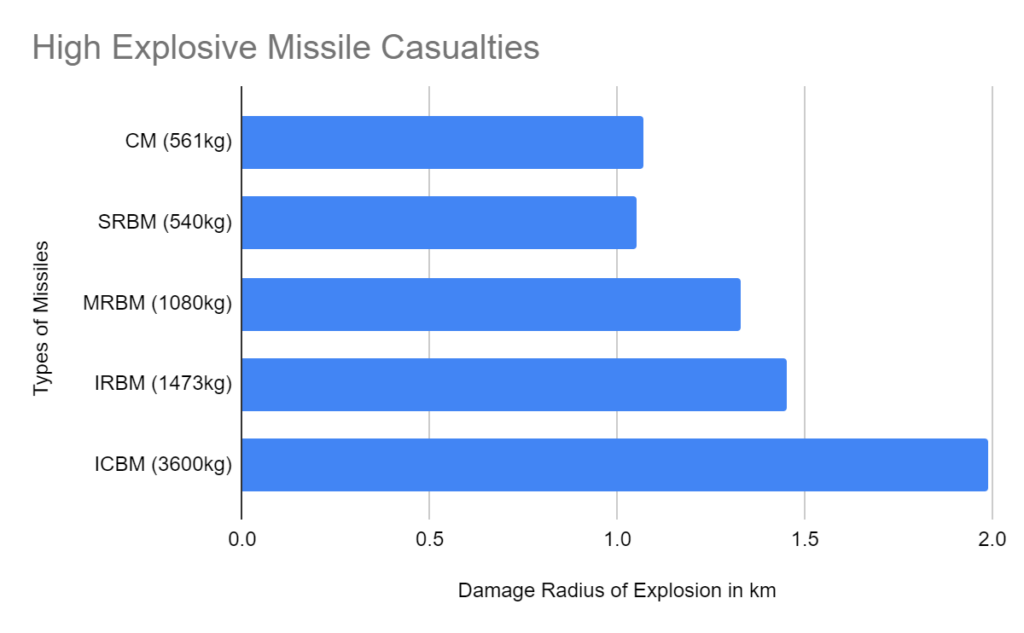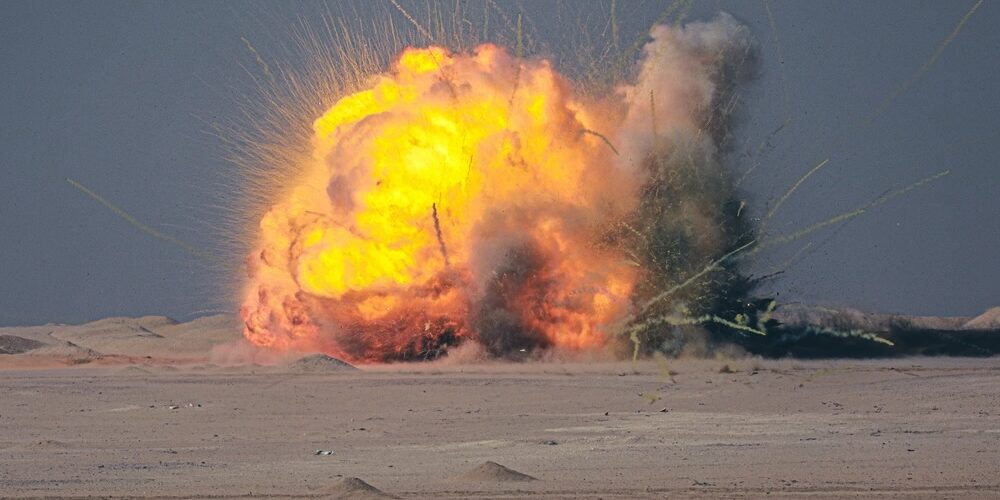Overview
This page analyzes the destructive cost of different missile warhead payloads. It provides an estimated range of explosion with estimated medical, fiscal, and humanitarian costs for each of the payload types.
Note: the statistics on this page use the maximum possible casualties from potential missile attacks. Actual figures may be lower due to the innumerable variables involved in calculating blast radius and casualties.
High Explosive
High explosive (HE) payloads are the one of the four payloads that can be applied to missile warheads and are the most common being considered conventional warheads. Being used extensively in the Ukraine conflict and in tests by North Korea, they are one of the most common weapons used in warfare and national defense. These missiles come in the form of Cruise Missiles (CM), Short Range Ballistic Missiles (SRBM), Medium Range Ballistic Missiles (MRBM), Intermediate Range Ballistic Missiles (IRBM), and Intercontinental Ballistic Missiles (ICBM). Many of these missiles vary in payload size, but the average of CMs are 561kg, SRBMs are 540kg, MRBMs are 1,080kg, IRBMs are 1,454kg, and ICBMs are 3,600kg. HE payloads may cause infrastructure destruction, fatalities, and injuries caused by fragmentations. [i]

A CM with an average of 561kg HE payload would create an explosive damage radius of up to 1.07km. In an urban center there could be up to 80,000 casualties in the affected area.
A SRBM with an average of 540kg HE payload would create an explosive damage radius of up to 1.06km. In an urban center there could be up to 77,600 casualties in the affected area.
A MRBM with an average of 1,080kg HE payload would create an explosive damage radius of up to 1.33km. In an urban center there could be up to 115,144 casualties in the affected area.
An IRBM with an average of 1,454kg HE payload would create an explosive damage radius of up to 1.99km. In an urban center there could be up to 132,510 casualties in the affected area.
An ICBM with an average of 3,600kg HE payload would create an explosive damage radius of up to 1.47km. In an urban center there could be up to 188,564 casualties in the affected area.
With an estimated cost of $100,000 based on each person in the affected area, it could cost up to $8 billion to rebuild from a cruise missile strike, $7.7 billion from a SRBM, $11.5 billion from a MRBM, $13.2 billion from a IRBM, and $18.8 billion from a ICBM; cost would vary depending on critical infrastructure hit and effects on outlying areas (i.e. water plant, electrical grid). [ii]
Nuclear/Radiation
Nuclear payloads are one of four that can be applied to missile warheads. They cause devastating destruction to both infrastructure and organic life through exerted explosive pressure and radiation. There is the initial fireball blast when the nuclear missile detonates, a shock wave that continues past the explosion, and then a thermal radiation wave that continues past the shock wave. All of these cause destruction in different ways, and the cost can be measured in multiple ways. Infrastructure damage can be measured by building destruction from the shockwave, human life damage from the thermal radiation wave, and both from the initial explosion. [iii]

The measurements compared in the graph above are yields needed to double the initial fireball blast radius each time. The yield has a general multiplication of 5.65 to double the blast radius.
A nuclear missile with a .5km initial blast radius would require a yield of 100kt and has a yield 5 times greater than the “Fat Man” and “Little Boy” bombs dropped during WWII. Buildings would collapse up to a 2.12km radius with thermal radiation causing 3rd degree burns extending to a 4km radius from the initial point of detonation. This size is considered to be a tactical nuclear weapon.
A nuclear missile with a 1km initial blast radius would require a yield of 560kt, 60kt stronger than the largest fission weapon tested by the US, the “Ivy King”. Buildings would collapse up to a 3.77km radius with thermal radiation causing 3rd degree burns extending to an 8.31km radius from the initial point of detonation.
A nuclear missile with a 2km initial blast radius would require a yield of 3.2Mt, the same yield as China’s Dong Feng-ICBM. Buildings would collapse up to a 6.76km radius with thermal radiation causing 3rd degree burns extending to a 17.7km radius from the initial point of detonation.
A nuclear missile with a 4km initial blast radius would require a yield of 18Mt, 3Mt larger than the largest US bomb tested, the “Castle Bravo”. Buildings would collapse up to a 12km radius with thermal radiation causing 3rd degree burns extending to a 36.8km radius from the initial point of detonation.
Based on the GDP for Washington D.C., a 100kt payload would cost $485 billion for initial damage and then an extra $3.12 in burn treatment for people in the thermal radiation range. [iv] A 560kt payload would cost $612 billion for initial destruction and burn treatments. A 3.2Mt payload would cost $837 billion for initial destruction and burn treatments. A 18Mt payload would cost over $1.1 trillion for initial destruction and burn treatments. Costs for rebuilding would be significant for complete reconstruction, estimated to be as high as $12.6 trillion if hit by a missile with an 18Mt payload, based on the HE rebuilding costs.
If a 100kt tactical nuclear missile were to make a surface detonation in the middle of a city, all buildings, subterranean transit, and people would be destroyed in an approximate 2km range in all directions. This cost increases if power grids and water treatment/pump stations are within this 2km range. Medical costs would be severe for people within the thermal radiation range. Countries have been investigating the use for these low yield tactical nuclear missiles for precision strikes as alternative weapons in their arsenals.
Biological
Biological agent payloads are one of the four that can be applied to missile warheads. Many agent types are not conducive for missile payloads due to the heat and kinetic motion from travelling and the final explosion, however there are a limited amount that are extremely heat stable and therefore have been historically tested as missile armaments. Anthrax is the most common, with Ricin and various toxins having limited production. North Korea has been suspected of producing large quantities of anthrax, using 10,000-liter fermentation chambers, for use in SRBMs. A SRBM based on a Scud-B variant may have a payload of up to 600kg, or 600L of a liquid solution. A missile with an anthrax payload would create a high-cost scenario in any environment.

600L of a liquid agent would be an approximate payload for a SRBM, with a 130m initial impact contamination range and droplet spread increasing to 540m. This type of payload can also be used in an airburst form to spread for longer distances at a greater height, with an initial impact contamination range of 400m and droplet spread increasing to 1500m.
The medical cost from a missile carrying a biological agent payload would be overwhelming. medical countermeasures for treatment anthrax exposure would be quickly exhausted and healthcare settings would be overwhelmed, causing an increase in secondary medical costs from other patients unable to get specific treatment. Depending on wind factors, the anthrax can be spread to greater distances and infect unsuspecting people, further increasing the fatalities and need for medical treatment. In more rural environments, high concentration of anthrax would remain and reproduce in the surrounding soil and be damaging to crops and livestock, causing high cost in the agricultural sector. [v]
Treatment for anthrax would include antibacterial rounds and specific anthrax vaccines, with an estimated overall treatment cost of $46,099 per person. [vi] Based on a cost of $320 million for decontamination of 42 buildings and processes as a result of the Anthrax Letters attack, with an average of 148 buildings per square km in urban settings, a surface impact explosion with a spread radius of 540m would cost $129.3 billion to decontaminate. [vii][viii] An airburst missile with a spread radius of 1.4km would cost $872.4 billion to decontaminate.
Chemical
Chemical agent payloads are one of the four that can be applied to missile warheads. Chemical agents are the simplest to produce while being fast acting and highly lethal, making them great threats from state and non-state actors alike. North Korea is known to possess large quantities of nerve agents, as well as other various types of chemical weapons. VX Nerve gas is one of the most lethal agents, causing death within minutes. A missile loaded with a VX Nerve gas payload would be devastating to a urban high-density population.

The nerve gas would be released in a concentrated cloud, causing fatalities within minutes in the immediate isolation range. A 2.4km evacuation range would be necessary, and a 7.4km protective action at night following wind patterns. Wind factors and sun exposure are variables that would affect the duration and density of the vapor cloud.
The medical costs for the immediate and evacuation ranges would be extremely large, with high loss of life that continuously increases closer to missile’s point of impact. With evaporation taking days, and under cold environments it can take months, widespread medical decontamination would be necessary along with relocation for people in the affected area which would be a substantial cost.
A counteracting agent is required to counter act the effects of the nerve agent, costing $3,610 per counteracting agent. [ix] With an estimated 210,000 in the range of the vapor cloud, it would cost $758.1 million to medically treat. A standard metric of $1 billion cost for an average natural disaster can be used to estimate decontamination, relocation, and destruction expenses for those in the immediate solation and evacuation ranges. A total cost would be $1.76 billion. [x]
References
[i] Explosion Danger Area Calculator | International Ammunition Technical Guidelines (unsaferguard.org)
[ii] How Much Would Building a New City Cost? (capitalfrontiers.com)
[iii] NUKEMAP by Alex Wellerstein
[iv] Washington metro area – GDP 2020 | Statista
[v] Anthrax can grow and reproduce in soil, researchers find (phys.org)
[vi] ANTHRAX TREATMENTS’ COST EFFECTIVENESS SHOWN IN STANFORD STUDY | News Center | Stanford Medicine
[vii] NEWS SCAN: Anthrax cleanup cost, susceptibility to anthrax toxin, C diff tracking | CIDRAP (umn.edu)
[viii] Dubai: number of buildings in urban areas by type 2019 | Statista
[x] Natural disasters have cost the US over $1.79T since 1980 – USAFacts

